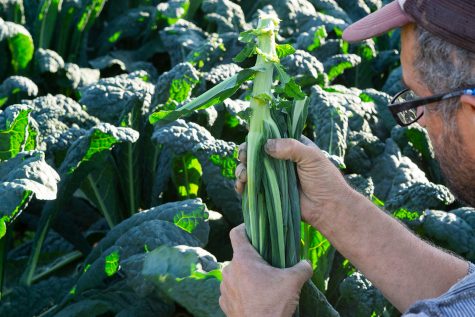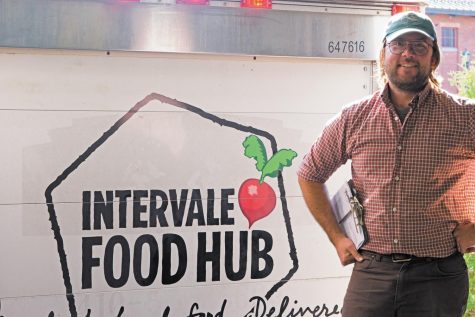Exploring the local food in UVM’s dining halls
October 22, 2019
A small truck steered around the corner and backed into the loading dock. In its refrigerated compartment, 1,500 pounds of diced potatoes sat alongside cases of local produce.

This week’s shipment arrived at UVM from Intervale Food Hub, a Burlington-based food distributor. According to the Food Hub’s purchasing manager, Keith Drinkwine, the organization is committed to connecting local farms with buyers ranging from households to institutions.
“We work with about 20 different farms within a 50-mile range to aggregate and distribute the food they produce,” Drinkwine said. “UVM is our largest wholesale account.”
As a large public university, UVM needs to dedicate a substantial amount of time and resources into the food options on campus.
Since 2008, the Real Food Challenge has been helping to structure how universities rely on sustainable food. According to UVM’s website, UVM signed the Real Food Campus Commitment in 2012.
According to the Real Food Challenge website, RFC aims to divert 20% of university food budgets nationwide towards local and community-based, fair, ecologically sound and humane sources.
Marissa Watson, UVM Dining sustainability manager, said that these distinctions help UVM and its food service provider, Sodexo, effectively support producers that promote ecological, economic and social sustainability.
“I think the RFC has helped us to not only support local farms, but also organic and fair trade farmers,” Watson said. “It is a really tangible and effective way to improve not only our personal health, but the health of our communities.”
According to the Real Food Calculator, UVM’s 17 Sodexo locations, including dining halls and restaurants, passed 26% Real Food in 2018.
Though UVM has made apparent progress with their food sourcing in recent years, the definition of “local” food may be different than the average student would think.

According to the 2018 Real Food Guide qualifications, produce can be defined as local if it is sourced within 250 miles of the buyer, and the individual farmer must make less than $5 million a year.
For meat, dairy, eggs and baked goods to be considered local, all production, processing and distribution facilities must exist within a 500-mile radius of the end consumer. The company or cooperative must also make less than $50 million a year.
Cities such as Detroit and Washington, D.C. might not be considered local to Vermonters, but they are still within the limits of this food radius.
David Conner, an economics professor at UVM who specializes in the economics of sustainable food systems, said this tendency to attach personal definitions to “local” comes from exposure to consumer markets, rather than a broader look at the local agricultural landscape.
“When people think of local farms, they think about who they see at a farmers market,” Conner said. “They probably don’t think of a commodity dairy farm as being local, because [large farms] don’t sell to local markets.”
While personal definitions of “local” may help small farms to create positive associations in direct markets, Conner said these associations do the opposite in wholesale markets, where small vendors have to compete with larger companies who also label their food as local.
Small farms simply do not have the scale to meet the need of an institution like UVM, though having a large university as a consistent buyer can provide unmatched financial security, Conner said.
Though a 250 to 500-mile radius may seem to change the meaning of “local,” this distance is much less than the average mileage that the typical American food product travels from farm to table. The typical distance is 1,500 to 2,500 miles, according to a 2002 Worldwatch Institute study.
“[Sodexo is] buying a lot of local food, and making a significant contribution to the agricultural economy and the working landscape,” Conner said. “I truly believe that their hearts are in the right place. They are dedicated to this.”
With his experience working with local food and at the Intervale, Drinkwine said choosing local means being able to meet the person that grows your food.
“It is about being able to shake the hand of the person who grew your food and ask them questions, or trusting them enough not to need to,” Drinkwine said.
This, he said, makes 26% Real Food an impressive figure.
Campus Executive Chef Brandon Williams said UVM is making significant progress in the right direction, and he attributes the movement’s success to his team, but also to students.
“None of this would be possible if it weren’t for the students,” Williams said. “I encourage students to engage more, and pay closer attention to what you are eating,”
Most importantly, he thinks students should ask questions and take the time to figure out what “real food” actually means.






